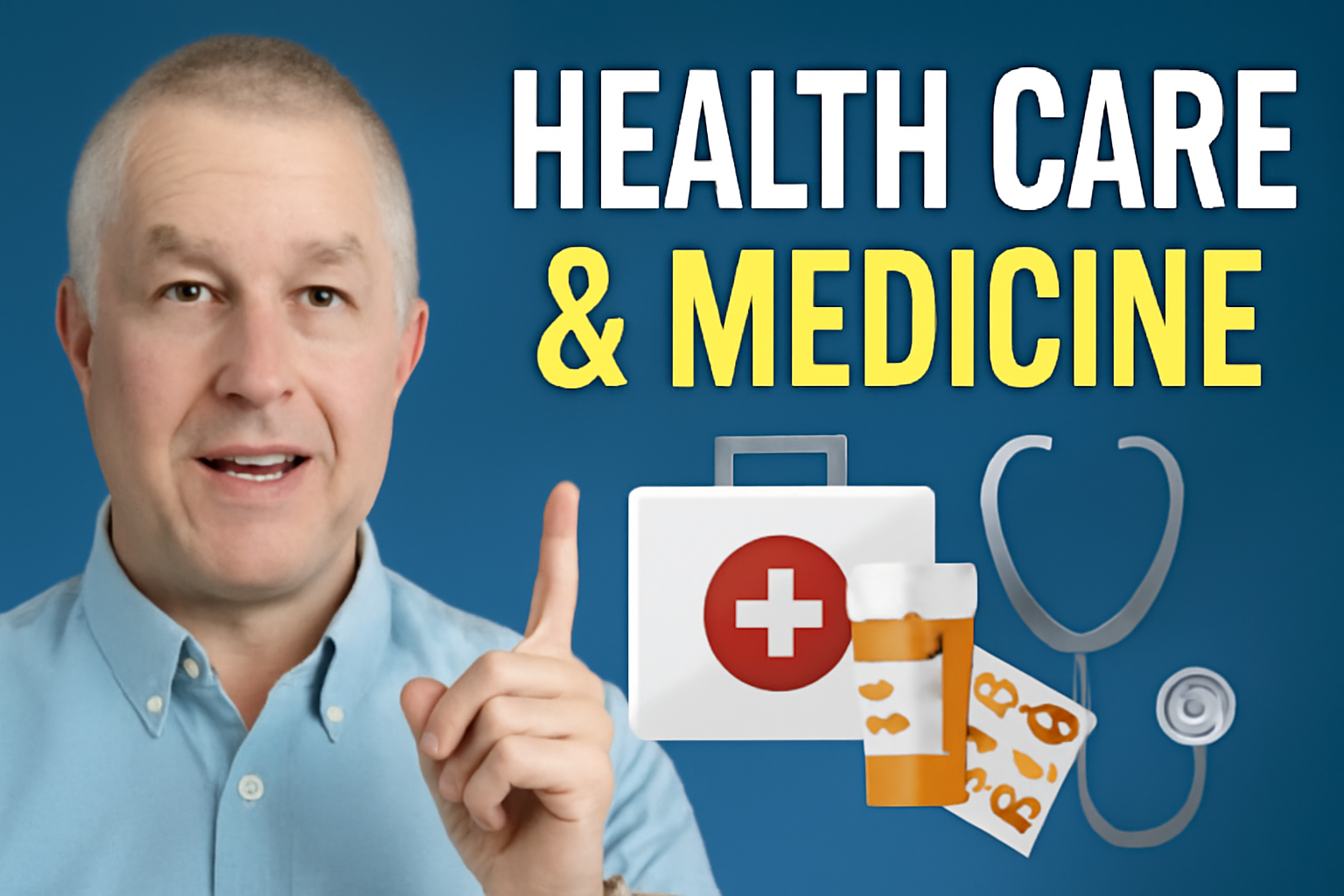Introduction to Healthcare and Medicine
Well hello and welcome to this English lesson about health care and medicine. In this English lesson, I’ll talk about all of the words and phrases you need to know to visit the doctor, go to the hospital, or simply have a conversation about your health. Whether you’re feeling ill, sick, or have hurt yourself, we’ll discuss the vocabulary and knowledge required to communicate effectively.
The Doctor: The Key Healthcare Professional
The main person you want to see if you’re not feeling well or if you’ve hurt yourself is the doctor. A doctor is the person who spent years studying the human body, diseases, illnesses, and how to treat them. Doctors have extensive training, sometimes memorizing a lot, to diagnose and treat a wide variety of medical conditions.
Nurses: The First Point of Contact
You might also see a nurse when you visit the doctor. Nurses have healthcare training, although they don’t study as long as doctors. They are usually the first to check your vitals, take your blood pressure and temperature, and record your symptoms before you see the doctor. They work closely with doctors to ensure proper treatment.
Surgeons: Specialists in Surgery
A surgeon is a special kind of doctor who performs surgery. If you need an operation to fix something inside your body, like a broken bone or heart issue, a surgeon is the one to help. Surgeons undergo additional years of training to learn how to operate and perform surgeries that can save lives.
Specialists: Experts in Specific Areas
Specialists are doctors who focus on specific areas of medicine. For example, if you have a sore back, your general practitioner may refer you to a specialist who has more knowledge and experience in treating that specific condition.
Paramedics: First Responders to Medical Emergencies
A paramedic is a medical professional who responds to emergencies, usually in an ambulance. They provide immediate treatment and help stabilize you before transporting you to the hospital. Paramedics are trained in first aid and know how to diagnose and treat injuries or sickness quickly.
Ambulance: Transport for Medical Emergencies
An ambulance is a specially equipped vehicle designed to transport sick or injured people to the hospital. It has all the necessary medical equipment and personnel on board to provide initial care during transport. In some cases, an air ambulance (helicopter) may be used for serious emergencies.
Medical Centers and Clinics: For Minor Health Concerns
Not all medical issues require a hospital visit. For minor illnesses, like a cold or mild fever, you would go to a medical center or clinic. These places are more accessible and often quicker for basic healthcare needs.
Waiting Rooms: The Anticipation of Care
When you visit a medical center or clinic, you’ll likely sit in a waiting room until you’re called to see the doctor or nurse. These rooms can sometimes be crowded and uncomfortable, but eventually, you’ll be called to proceed with your medical consultation.
Doctor’s Office: The Space for Diagnosis and Treatment
The doctor’s office is where your consultation happens. It’s typically equipped with essential medical tools, such as a heart rate monitor, stethoscope, and other devices needed for a thorough check-up. During your visit, the doctor will assess your condition and may order tests or recommend treatments.
Hospital: The Place for Serious Medical Care
Hospitals are large medical facilities equipped to handle a wide range of medical issues. They are where doctors, nurses, and surgeons work together to provide care. If you have an emergency or need major surgery, the hospital is where you will be treated.
Symptoms and Diagnosis: Identifying What’s Wrong
When you visit a healthcare provider, they will ask about your symptoms to help diagnose your condition. Symptoms like a sore throat, fever, or stuffed-up nose are clues that help doctors determine the cause of your illness. Once diagnosed, they will recommend treatment to help you recover.
Treatment: The Plan to Heal
Treatment is the plan devised by a doctor based on the diagnosis. It could include medication, surgery, or other forms of care, such as physical therapy. The goal is always to improve your health and help you recover from whatever condition you’re facing.
Infections and Antibiotics: Tackling Bacterial Infections
An infection happens when harmful bacteria invade your body. In many cases, antibiotics are prescribed to fight the bacteria and help your body recover. If you have an infection, your healthcare provider will likely prescribe an antibiotic to help eliminate it.
Stethoscope and Blood Pressure: Monitoring Your Health
Healthcare professionals use tools like stethoscopes to listen to your heart and lungs. Blood pressure is another crucial measurement that helps doctors assess your cardiovascular health. These tools provide vital signs that are important for determining your overall health.
Thermometers and X-Rays: Diagnosing with Technology
Thermometers are used to measure your body temperature. A high temperature could indicate a fever, often caused by an infection. If you have an injury or suspect a broken bone, an X-ray might be ordered to examine your body and identify any fractures or issues inside.
Ultrasound: Visualizing Internal Organs and Babies
An ultrasound uses sound waves to create images of the inside of your body. It is commonly used to monitor pregnancies, allowing doctors to see the baby inside the womb. Ultrasound can also be used to check internal organs like the heart, liver, and kidneys for any potential issues.
Weight and Height: Essential Measurements
When visiting a healthcare provider, they often measure your weight and height. These measurements help doctors track your overall health and can indicate any potential issues, such as underweight or overweight concerns.
Vaccination and Injections: Preventive and Therapeutic Care
Vaccinations are injections that help your body build immunity to diseases. Injections can also be used for other treatments, such as antibiotics or pain management. They are administered using a needle or syringe.
Blood Tests: Analyzing Your Health Through Blood Samples
Blood tests are essential tools for diagnosing various conditions. A blood test involves taking a sample of your blood and sending it to a lab for analysis. This can help identify infections, deficiencies, or other underlying health issues.
Crutches and Wheelchairs: Assisting with Mobility
When you have a leg injury or difficulty walking, crutches or a wheelchair may be used to assist with mobility. These tools make it easier to move around and help protect the injured area from further damage.
Hospital Admission: Staying Overnight for Care
If your condition requires more intensive treatment, you may be admitted to the hospital. This means you will stay in a hospital bed and receive continuous care until you are well enough to go home.
Maternity Ward: The Place for Newborns and Mothers
The maternity ward is a special area in the hospital where babies are born. It includes rooms for labor and delivery, as well as for mothers to recover after childbirth. Hospitals provide a safe space for both mothers and babies during and after the birth process.
Conclusion: Navigating the Healthcare System
Understanding healthcare terms and procedures can make your visit to the doctor or hospital much smoother. From the initial consultation with a nurse to receiving a diagnosis and treatment, knowing the right vocabulary helps you navigate your healthcare journey with ease.



